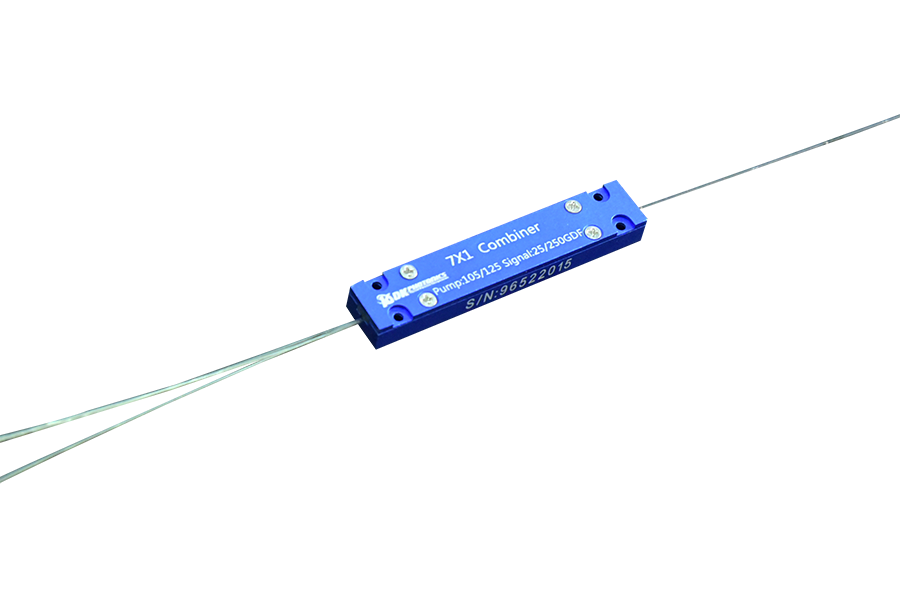Multimode pump combiners are an important component in many high-power fiber laser systems. As the name suggests, these devices combine multiple pump laser diodes into a single output fiber to efficiently scale pump power. This post provides an overview of multimode pump combiner features and their common uses.
What is a Multimode Pump Combiner?
A multimode pump combiner, sometimes called a (N+1)x1 combiner, allows combining N multimode pump fibers and 1 single mode signal fiber into one output fiber. It lets you increase power effectively by combining multiple lower-power multimode pump lasers into a high-power pump source.
The key components of a multimode pump combiner are:
Pump Ports: Pump ports are used for the input of pump laser diodes, usually using 105/125um or 135/155um multimode fibers to provide the pump with powerful optical wavelengths into the device.
Signal Port: The signal port is used for the input of the fiber that carries the signal or data to be amplified. This is usually a single-mode fiber like 10/125um to maintain the optical signal quality.
Output Port: There is a single fiber output port that combines the signal wavelength and all pump wavelengths into one output fiber to continue transmitting.
Wavelength Selective Coupler: Inside the device is a wavelength selective coupler that combines different pump wavelengths and signal wavelengths into a single output fiber with a low insertion loss across every wavelength.
Package: The package contains and protects the inside wavelength selective coupler and other components. It also provides heat sinking and thermal management to remove excess heat generated during operation. The package allows connections of fiber inputs and outputs to the internal components.
Multimode Pump Combiner Architectures
There are two main structures used in multimode pump combiners:
Reflective Combiners
Reflective combiners use a common leg with dichroic mirrors that reflect pump wavelengths as they transmit the wavelength. This offers a simple and low-loss design. However, the common leg can limit power handling.
Wavelength Division Multiplexers
WDM-based combiners connect every pump and the signal separately into the output using wavelength-selective couplers. This architecture offers excellent power handling and scalability for a larger number of pumps. But it can have higher costs and complexity.
Key Features and Benefits
Multimode pump combiners offer several important features that make them critical components in scaling to high signal and pump powers:
High Power Handling: They can combine multiple 50W or higher pump diodes for 100s of Watts of pump power.
High Efficiency: They typically have >90% power transfer efficiency, preserving brightness.
Low Loss: A signal insertion loss as low as 0.8dB enables high signal power.
Reliability: They offer robust packaging and thermal management for reliable operation.
Custom Configurations: They are available with a wide range of pumps, wavelengths, and fiber compatibility.
Compact: These combiners take up minimal space compared to combining pump fibers externally.
Typical Applications
The ability of multimode pump combiners to efficiently scale up pump power is useful in:
High-Power Fiber Lasers: Efficiently pump kW-level ytterbium, thulium, or erbium fiber lasers.
Fiber Amplifiers: Combine pumps for high-power EDFAs and Raman amplifiers.
Materials Processing: Power scaling for direct diode materials processing.
Medical: Pump combiners for high-power medical laser systems.
Defense: High energy laser (HEL) systems for military use.
Instrumentation: Pump combining for metrology, spectroscopy, LIDAR, etc.
Telecom: Pump sources for optical amplification and DWDM systems.
Research: Multimode pumping of specialty fibers for research.
Multimode pump combiners enable efficient and compact scaling of pump powers for high-power fiber laser systems across a multitude of applications. Their unique features make them an important building block for multi-kW fiber lasers and amplifiers.


Leave A Comment